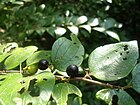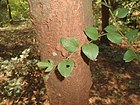Note: This is a project under development. The articles on this wiki are just being initiated and broadly incomplete. You can Help creating new pages.
Difference between revisions of "Ziziphus xylopyra"
(Created page with "{{stub}} ==Uses== {{Uses|}}, {{Uses|}}, {{Uses|}}, {{Uses|}}, {{Uses|}}, {{Uses|}}, {{Uses|}}, {{Uses|}}, {{Uses|}}, {{Uses|}}, {{Uses|}}.<ref name="Uses"/> ==Parts Used== {{...") |
|||
| Line 1: | Line 1: | ||
| − | + | [[File:Ziziphus xylopyrus AJTJ DSCN0180.jpg|thumb|right]] | |
| + | '''Ziziphus abyssinica''' is a fiercely thorny, semideciduous plant, varying in habit from an erect shrub; a scrambling plant that clambers into other vegetation for support; or a tree with drooping branches that form a heavy, rounded crown. It usually grows from 3 - 12 metres tall. The bole is usually straight. The plant is harvested from the wild as a local source of food, medicines and other materials. It is sometimes cultivated as a stock-proof hedge. | ||
==Uses== | ==Uses== | ||
| − | {{Uses|}}, {{Uses|}}, {{Uses| | + | {{Uses|Stomachache}}, {{Uses|Snakebite}}, {{Uses|Pneumonia}}.<ref name="Uses"/> |
==Parts Used== | ==Parts Used== | ||
| − | {{Parts Used|}}, {{Parts Used| | + | {{Parts Used|Fruits}}, {{Parts Used|Leaves}}. |
==Chemical Composition== | ==Chemical Composition== | ||
| − | <ref name="chemical composition"/> | + | The major chemical composition of Z. xylopyrus are rich in flavonoids in particular quercetin, quercitrin, kaempferol-4’-methylether and kaempferol, tannins (7.2%), d-7, 3’, 4’-trihydroxyflavan-3, 4-diol and oleanolic acid etc.<ref name="chemical composition"/> |
==Common names== | ==Common names== | ||
| Line 16: | Line 17: | ||
===Dravya=== | ===Dravya=== | ||
===Rasa=== | ===Rasa=== | ||
| − | |||
===Guna=== | ===Guna=== | ||
| Line 29: | Line 29: | ||
==Habit== | ==Habit== | ||
| − | {{Habit|}} | + | {{Habit|Semi-deciduous shrub}} |
==Identification== | ==Identification== | ||
| Line 48: | Line 48: | ||
==Mode of Propagation== | ==Mode of Propagation== | ||
| − | {{Propagation|}} | + | {{Propagation|Seeds}} |
==How to plant/cultivate== | ==How to plant/cultivate== | ||
| − | <ref name="How to plant/cultivate"/> | + | A plant usually of the drier areas of the hot tropics, where it can be found at elevations from 400 - 2,000 metres.<ref name="How to plant/cultivate"/> |
==Commonly seen growing in areas== | ==Commonly seen growing in areas== | ||
| − | {{Commonly seen|}}, {{Commonly seen|}}, {{Commonly seen| | + | {{Commonly seen|Scattered tree grassland}}, {{Commonly seen|Combretum-Terminalia woodlands}}, {{Commonly seen|Acacia woodlands}}. |
==Photo Gallery== | ==Photo Gallery== | ||
<gallery class="left" caption="" widths="140px" heights="140px"> | <gallery class="left" caption="" widths="140px" heights="140px"> | ||
| − | + | (Ziziphus xylopyrus) at Kambalakonda Wildlife Sanctuary.jpg | |
| + | (Ziziphus xylopyrus) tree bark at Kambalakonda.jpg | ||
| + | Ghator (Hindi- घटोर) (9971660253).jpg | ||
| + | Raw woody-fruited jujube fruit (Ziziphus xylopyrus) at Kambalakonda Wildlife Sanctuary.jpg | ||
| + | Ziziphus xylopyrus - fruits.JPG | ||
| + | Ziziphus xylopyrus AJTJ DSCN0180.jpg | ||
</gallery> | </gallery> | ||
| Line 64: | Line 69: | ||
<references> | <references> | ||
| − | <ref name="chemical composition">[ | + | <ref name="chemical composition">[https://www.farmavita.net/farmavitanet-journal/life-science-files/53-life-science-article/1626-zizyphus-xylopyrus#:~:text=The%20major%20chemical%20composition%20of,4%2Ddiol%20and%20oleanolic%20acid. Chemical constituents]</ref> |
| − | <ref name="Leaf">[ | + | <ref name="Leaf">[Morphology]</ref> |
| − | <ref name="How to plant/cultivate">[ | + | <ref name="How to plant/cultivate">[http://tropical.theferns.info/viewtropical.php?id=Ziziphus+abyssinica Cultivation]</ref> |
<ref name="Uses">Indian Medicinal Plants by C.P.Khare</ref> | <ref name="Uses">Indian Medicinal Plants by C.P.Khare</ref> | ||
</references> | </references> | ||
==External Links== | ==External Links== | ||
| − | * [ ] | + | * [https://indiabiodiversity.org/species/show/31935 Ziziphus xylopyra on indiabiodiversity.org] |
| − | * [ ] | + | * [https://pdfs.semanticscholar.org/4440/841b2cd4ac8e077d75c2369aec8538910929.pdf Ziziphus xylopyra on semanticscholar.org] |
| − | + | ||
[[Category:Herbs]] | [[Category:Herbs]] | ||
Revision as of 16:00, 10 September 2020
Ziziphus abyssinica is a fiercely thorny, semideciduous plant, varying in habit from an erect shrub; a scrambling plant that clambers into other vegetation for support; or a tree with drooping branches that form a heavy, rounded crown. It usually grows from 3 - 12 metres tall. The bole is usually straight. The plant is harvested from the wild as a local source of food, medicines and other materials. It is sometimes cultivated as a stock-proof hedge.
Contents
- 1 Uses
- 2 Parts Used
- 3 Chemical Composition
- 4 Common names
- 5 Properties
- 6 Habit
- 7 Identification
- 8 List of Ayurvedic medicine in which the herb is used
- 9 Where to get the saplings
- 10 Mode of Propagation
- 11 How to plant/cultivate
- 12 Commonly seen growing in areas
- 13 Photo Gallery
- 14 References
- 15 External Links
Uses
Stomachache, Snakebite, Pneumonia.[1]
Parts Used
Chemical Composition
The major chemical composition of Z. xylopyrus are rich in flavonoids in particular quercetin, quercitrin, kaempferol-4’-methylether and kaempferol, tannins (7.2%), d-7, 3’, 4’-trihydroxyflavan-3, 4-diol and oleanolic acid etc.[2]
Common names
| Language | Common name |
|---|---|
| Kannada | |
| Hindi | |
| Malayalam | |
| Tamil | |
| Telugu | |
| Marathi | |
| Gujarathi | |
| Punjabi | |
| Kashmiri | |
| Sanskrit | |
| English |
Properties
Reference: Dravya - Substance, Rasa - Taste, Guna - Qualities, Veerya - Potency, Vipaka - Post-digesion effect, Karma - Pharmacological activity, Prabhava - Therepeutics.
Dravya
Rasa
Guna
Veerya
Vipaka
Karma
Prabhava
Habit
Identification
Leaf
| Kind | Shape | Feature |
|---|---|---|
Flower
| Type | Size | Color and composition | Stamen | More information |
|---|---|---|---|---|
| {{{5}}} |
Fruit
| Type | Size | Mass | Appearance | Seeds | More information |
|---|---|---|---|---|---|
Other features
List of Ayurvedic medicine in which the herb is used
Where to get the saplings
Mode of Propagation
How to plant/cultivate
A plant usually of the drier areas of the hot tropics, where it can be found at elevations from 400 - 2,000 metres.[4]
Commonly seen growing in areas
Scattered tree grassland, Combretum-Terminalia woodlands, Acacia woodlands.
Photo Gallery
References
- ↑ Indian Medicinal Plants by C.P.Khare
- ↑ Chemical constituents
- ↑ [Morphology]
- ↑ Cultivation
External Links
- Ayurvedic Herbs known to be helpful to treat Stomachache
- Ayurvedic Herbs known to be helpful to treat Snakebite
- Ayurvedic Herbs known to be helpful to treat Pneumonia
- Herbs with Fruits used in medicine
- Herbs with Leaves used in medicine
- Habit - Semi-deciduous shrub
- Index of Plants which can be propagated by Seeds
- Herbs that are commonly seen in the region of Scattered tree grassland
- Herbs that are commonly seen in the region of Combretum-Terminalia woodlands
- Herbs that are commonly seen in the region of Acacia woodlands
- Herbs






